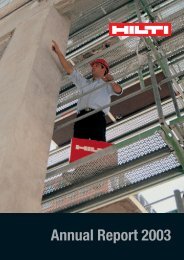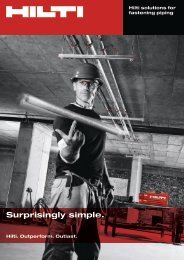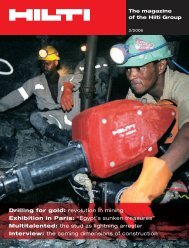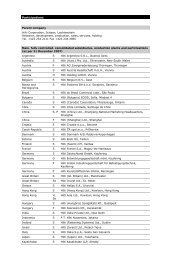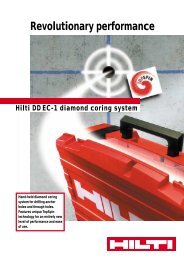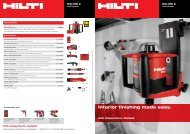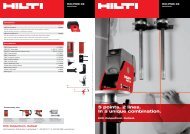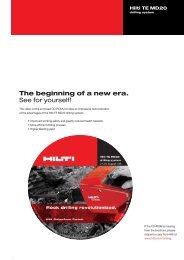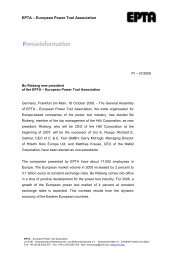Tool selector. Choose the right Hilti tool.
Tool selector. Choose the right Hilti tool.
Tool selector. Choose the right Hilti tool.
Create successful ePaper yourself
Turn your PDF publications into a flip-book with our unique Google optimized e-Paper software.
<strong>Tool</strong> <strong>selector</strong> 08/2011<br />
Disclaimer<br />
Disclaimer for power <strong>tool</strong> <strong>selector</strong><br />
The vibration emission levels given in this information sheet have<br />
been measured in accordance with a standardised test described in<br />
EN 60745-1: 2006 or EN 61029 and may be used to compare one<br />
<strong>tool</strong> with ano<strong>the</strong>r. They may be used for a preliminary assessment<br />
of exposure.<br />
The declared vibration emission levels represent <strong>the</strong> main applications<br />
of <strong>the</strong> <strong>tool</strong>s. However if <strong>the</strong> <strong>tool</strong>s are used for different<br />
applications, with different accessories or are poorly maintained, <strong>the</strong><br />
vibration emission may differ. This may significantly increase <strong>the</strong><br />
exposure level over <strong>the</strong> total working period.<br />
An estimation of <strong>the</strong> level of exposure to vibration should also take<br />
into account <strong>the</strong> times when <strong>the</strong> <strong>tool</strong> is switched off or when it is<br />
running but not actually doing <strong>the</strong> job. This may significantly reduce<br />
<strong>the</strong> exposure level over <strong>the</strong> total working period.<br />
Identify additional safety measures to protect <strong>the</strong> operator from <strong>the</strong><br />
effects of vibration such as: maintain <strong>the</strong> <strong>tool</strong> and <strong>the</strong> accessories,<br />
keep <strong>the</strong> hands warm, organisation of work patterns.<br />
Disclaimer for direct fastening <strong>selector</strong><br />
The vibration and noise values listed in this table are generated<br />
from laboratory tests and do not guarantee actual recoil values in any<br />
specific application on site. The values are rounded averages.<br />
These vibration and noise values are <strong>the</strong>refore to be used as a guideline<br />
only. The employer is responsible for adhering to legal requirements<br />
applicable to workplace health and safety and for evaluation<br />
of <strong>the</strong> actual vibration and noise values by taking <strong>the</strong> appropriate<br />
on-site measurements.<br />
Underlying measurements for vibration values are one-dimensional<br />
and taken in typical applications under laboratory conditions in<br />
accordance with ISO 8662-11.<br />
Underlying measurements for noise values are taken in typical<br />
applications under laboratory conditions in accordance with EN 12<br />
549 acoustics – noise test code for fastener driving <strong>tool</strong>s.<br />
The respective numbers shown in <strong>the</strong> <strong>selector</strong> indicate as follows:<br />
– Rotary hammers (1):<br />
Numbers of holes that can be drilled in one working day without<br />
exceeding <strong>the</strong> exposure action value or exposure limit value as<br />
defined in <strong>the</strong> EU vibration directive 2002/44/EC.<br />
– Combi hammers (2):<br />
Numbers of holes that can be drilled or respectively <strong>the</strong> size of opening<br />
that can be chiselled in one working day without excee-ding<br />
<strong>the</strong> exposure action value or exposure limit value as defined in <strong>the</strong><br />
EU vibration directive 2002/44/EC.<br />
– Breakers (3):<br />
The size of opening that can be chiselled in one working day<br />
without exceeding <strong>the</strong> exposure action value or exposure limit<br />
value as defined in <strong>the</strong> EU vibration directive 2002/44/EC.<br />
– Diamond coring <strong>tool</strong>s (4):<br />
Numbers of hole that can be drilled in one working day without<br />
exceeding <strong>the</strong> exposure action value or exposure limit value as<br />
defined in <strong>the</strong> EU vibration directive 2002/44/EC.<br />
– Reciprocating saws (5):<br />
Number of cutting meters that can be cut or respectively <strong>the</strong><br />
number of cuts that can be performed in one working day without<br />
exceeding <strong>the</strong> exposure action value or exposure limit value as<br />
defined in <strong>the</strong> EU vibration directive 2002/44/EC.<br />
The vibration values listed are triaxial measurements made in accordance<br />
with EN 60745-1:2006 or EN 61029. The vibration values<br />
shown are generated from laboratory test data and do not guarantee<br />
actual vibration values for any specific application on site. The values<br />
are rounded averages.<br />
Noise values are measured in accordance with EN 60745-1:2006 or<br />
EN 61029. Regardless of <strong>the</strong> noise value, <strong>Hilti</strong> strongly recommends<br />
that appropriate noise protection is worn.<br />
The material used for <strong>the</strong> measurements is defined as following:<br />
– Rotary hammers, combi hammers, breakers and diamond coring<br />
<strong>tool</strong>s are measured on concrete with a minimum compressive<br />
strength of 40 N/mm2 (after 28 days). The concrete is not reinforced.<br />
The depth of <strong>the</strong> holes drilled is stated in <strong>the</strong> respective table.<br />
– Reciprocating saws are measured on chipboard with <strong>the</strong> dimensions<br />
of 600 x 38 mm and beams of fir wood with <strong>the</strong> dimensions<br />
of 100 x 100 mm.<br />
The size of opening chiselled by <strong>the</strong> small breakers up to and including<br />
<strong>the</strong> TE 706 represents chiselling out an opening in a wall (e.g. for<br />
a window) in solid material, i.e. <strong>the</strong> opening is surrounded by concrete<br />
on all sides.<br />
When chiselling at <strong>the</strong> edge of a slab, performance is higher by a<br />
factor of 2–3. With <strong>the</strong> TE 805 and TE 905-AVR, <strong>the</strong> application is demolition<br />
chiselling towards <strong>the</strong> ground on an edge.<br />
The productivity values are calculated on <strong>the</strong> basis of <strong>the</strong> vibration<br />
value and performance of <strong>the</strong> <strong>tool</strong> and are measured in <strong>the</strong> procedures<br />
according to EN 60745-1:2006 or EN 61029. They vary, depending<br />
on many factors, such as <strong>the</strong> material, possible rebar hits, type and<br />
sharpness of <strong>the</strong> bit, chisel or blade used and <strong>the</strong> working behaviour<br />
of <strong>the</strong> user etc. All values are measured using new <strong>Hilti</strong> power <strong>tool</strong>s<br />
and bits, chisels, blades etc.<br />
Drilling into or through rebars influences <strong>the</strong> rate of drilling progress<br />
and vibration emissions. This, as a rule, leads to a significant reduction<br />
of overall productivity (decrease in <strong>the</strong> number of holes drilled).<br />
The values given in <strong>the</strong> <strong>tool</strong> and application <strong>selector</strong>s are <strong>the</strong>refore<br />
to be used only as a guideline. The employer is responsible for ensuring<br />
that limit values are not exceeded.<br />
The efficiency of dust removal systems depends strongly on <strong>the</strong>ir<br />
correct use as well as <strong>the</strong> conditions on <strong>the</strong> jobsite, e.g. <strong>the</strong> type<br />
and surface shape of <strong>the</strong> material worked on. The values given and<br />
statements made with respect to dust removal are <strong>the</strong>refore an<br />
indication only.<br />
Dust from material such as paint containing lead, some wood species,<br />
minerals and metal may be harmful. Contact with or inhalation of<br />
<strong>the</strong> dust may cause allergic reactions and/or respiratory diseases to<br />
<strong>the</strong> operator or bystanders.<br />
Certain kinds of dust are classified as carcinogenic such as oak and<br />
beech dust especially in conjunction with additives for wood conditioning<br />
(chromate, wood preservative). Material containing asbestos<br />
must only be treated by specialists.<br />
• Where <strong>the</strong> use of a dust extraction device is possible it shall be used.<br />
• The work place must be well ventilated.<br />
• The use of a dust mask of filter class P2 is recommended.<br />
Follow national requirements for <strong>the</strong> materials you want to work with.<br />
<strong>Hilti</strong> – your preferred partner for productivity and safety on <strong>the</strong> jobsite<br />
www.hilti.com 11



